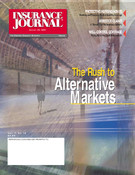This is a tale of two companies. Both made similar products and sold them to other companies. Both did what companies do: they extended credit to their commercial customers for a period of several weeks and, naturally, expected to be paid.
Both companies coincidentally sold their products to the same customer and submitted invoices stating that payment was due in 30 days. Both companies trusted their customer to pay, even though they knew that title to the product passed to the customer once it left their premises. But one fundamental difference existed between the two companies.
Company A was aware that there was a form of property/casualty insurance available to protect it should its customer be unable or unwilling to pay for the product. Company A had once suffered an unexpected loss, which had been excessive and nearly catastrophic. That was before it had known about commercial credit insurance. Now it knew better and was not about to take any more unnecessary risks.
Company B, however, was dangerously unaware that any form of insurance was even available to protect it from the insolvency or past dues of its customer. Its insurance broker was also ignorant of the product, even though it had been around for over 100 years.
What happened next was that the customer who bought the products from both Company A and Company B was hit by its own customer’s inability to pay. The dreary scenario, which can be likened to a financial version of the domino effect, progressed with fraKtic phone calls, faxes and e-mail messages flying between all concerned.
To cut a long and familiar story short, the customer filed for relief under Chapter 11 of the U.S. Bankruptcy Code. Just like its customer, and its customer’s customer, Company B simply could not sustain the severe loss and chose also to file Chapter 11W Company B’s creditors were not cooperative and forced it into Chapter 7—and history.
ýNot so for Company A. True, it had also suffered a heavy loss, but it had insured its customer’s financial obligation to pay for the goods it received by submitting the account to a commercial credit insurance company. The insurer had accepted the risk. Company A filed a claim and was subsequently reimbursed within 60 days by the insurance company, which then assumed the role of creditor for that particular bad debt.
This cautionary tale is being repeated with increasing regularity in the business marketplace. More and more companies are realizing that commercial credit insurance is a vital weapon in their armory against the spate of bankruptcies that are plaguing tke economy. And more and more firms are realizing that the cost for such protection is surprisingly low.
Typically, a commercial credit insurance policy coats a small fraction of one percent of covered sales. Though most policyholders insure all their accounts, blue chip customers are often excluded with a saving in premium. Coverage is not limited only toüwell-rated accounts, but can extend also to marginal accounts. The policy covers credit losses from sales made on open account terms, and the actual risk of extending credit is thus insured. In short, it is a guarantee that the seller (the policyholder) will be paid for merchandise shipped or services rendered.
Many companies that in the past felt that they could afford to self-insure, now realize that it is pretty frustrating to operate for a good part of the trading year at no profit merely to overcome such trade losses—with a commensurate reduction in their working capital. In most instances, there is no longer a tax deduction allowed for a bad debt reserve.
Premiums for commercial credit insurance, on the other hand, are an ordinary business expense and are fully tax deductible. Apart from the peace of mind that comes with insuring accounts receivable from the ravages of insolvency, many companies now real}ze that their lenders also favor the insurance coverage because loans are made more secure if the receivables are insured.
Commercial credit insurance is available both for domestic coverage in the U.S. and Canada, and for foreign export coverage throughout the rest of the world. With the new and exciting challenges for business in the international market place, and the desire by foreign customers to receive open account terms from U.S. suppliers, it is a foolhardy business indeed that would sell on open account terms without at least insuring part of its accounts receivable exposure.
Victor Sharpe is the General Agent for CNA Credit Insurance and covers the Pacific Northwest from offices in Portland and Seattle. He can be contacted at cnapdx@verizon.net.
Topics USA
Was this article valuable?
Here are more articles you may enjoy.


 German Insurtech Wefox to Replace CEO After Board Rejects Mubadala Sales Plan
German Insurtech Wefox to Replace CEO After Board Rejects Mubadala Sales Plan  Big ‘I’ Report: Independent Agency Channel Placed 62% of Premiums in 2023
Big ‘I’ Report: Independent Agency Channel Placed 62% of Premiums in 2023  Let Good Adjusters, Not Expensive Lawyers, Make the Difference on Claims, CEO Says
Let Good Adjusters, Not Expensive Lawyers, Make the Difference on Claims, CEO Says  US P/C Insurers Post Best Q1 Underwriting Result In 17 Years
US P/C Insurers Post Best Q1 Underwriting Result In 17 Years 


